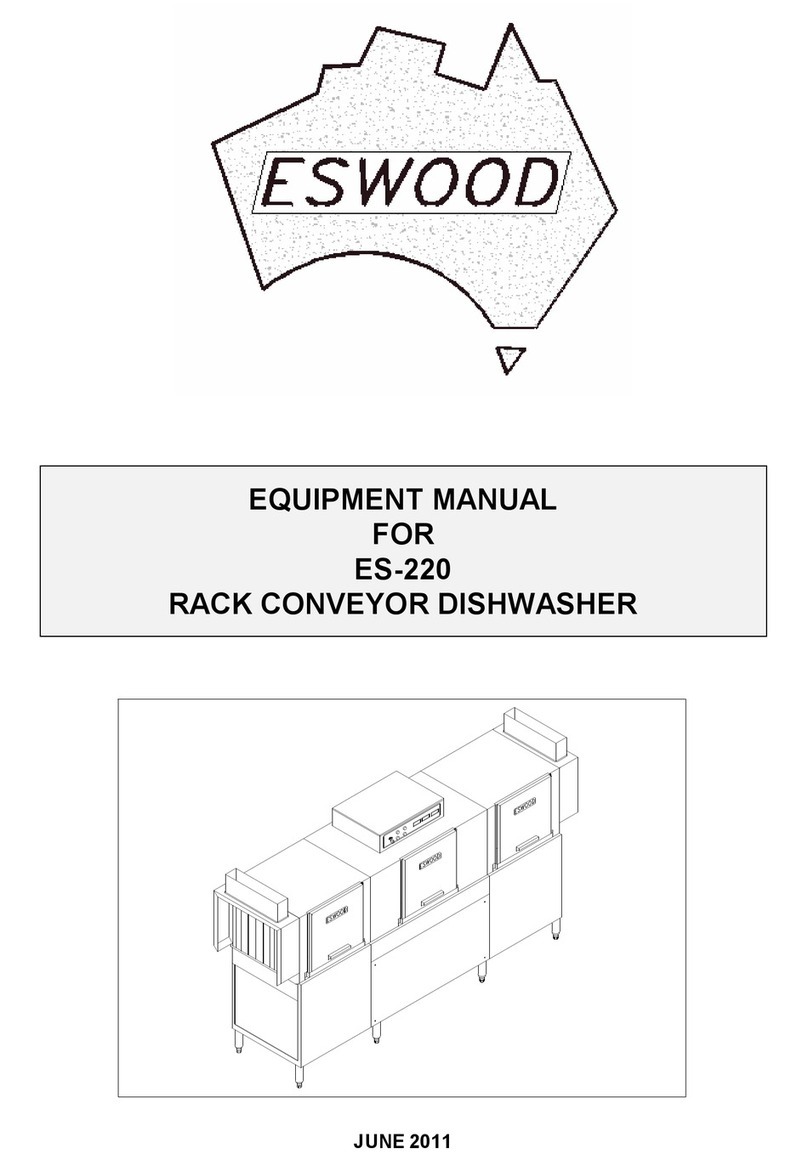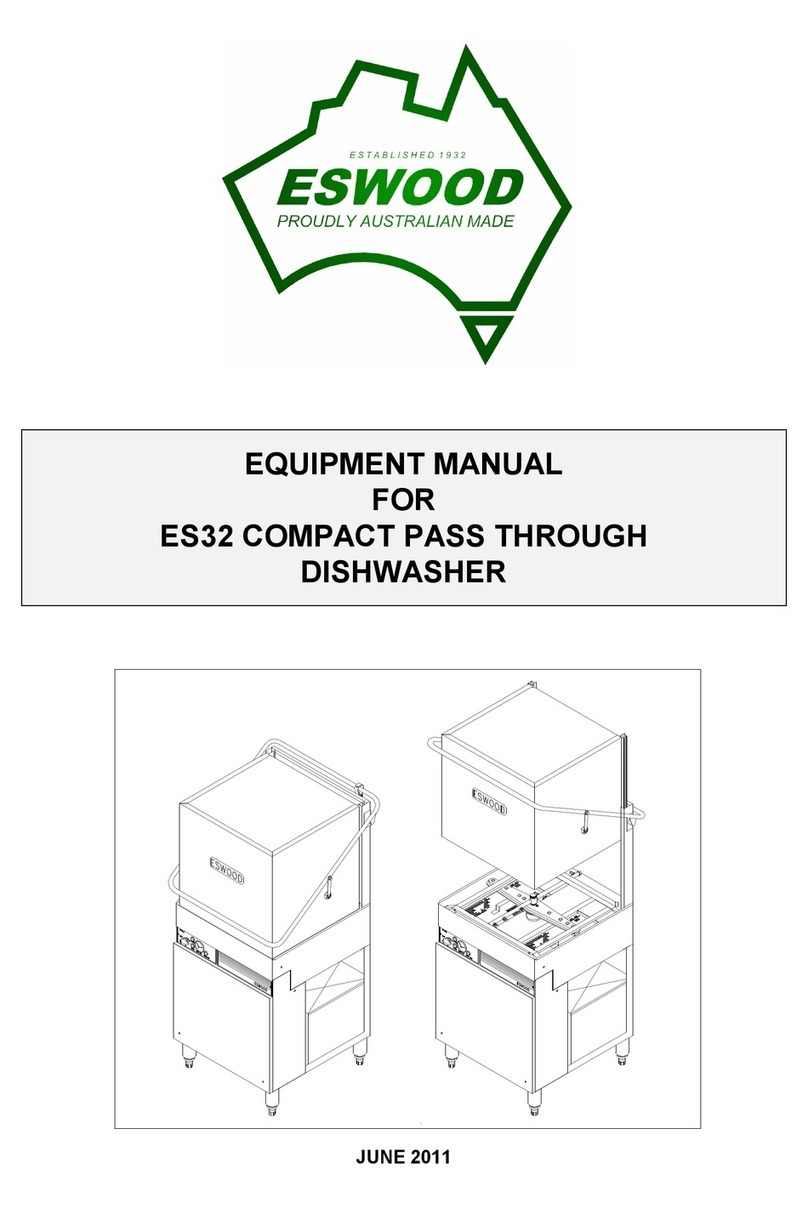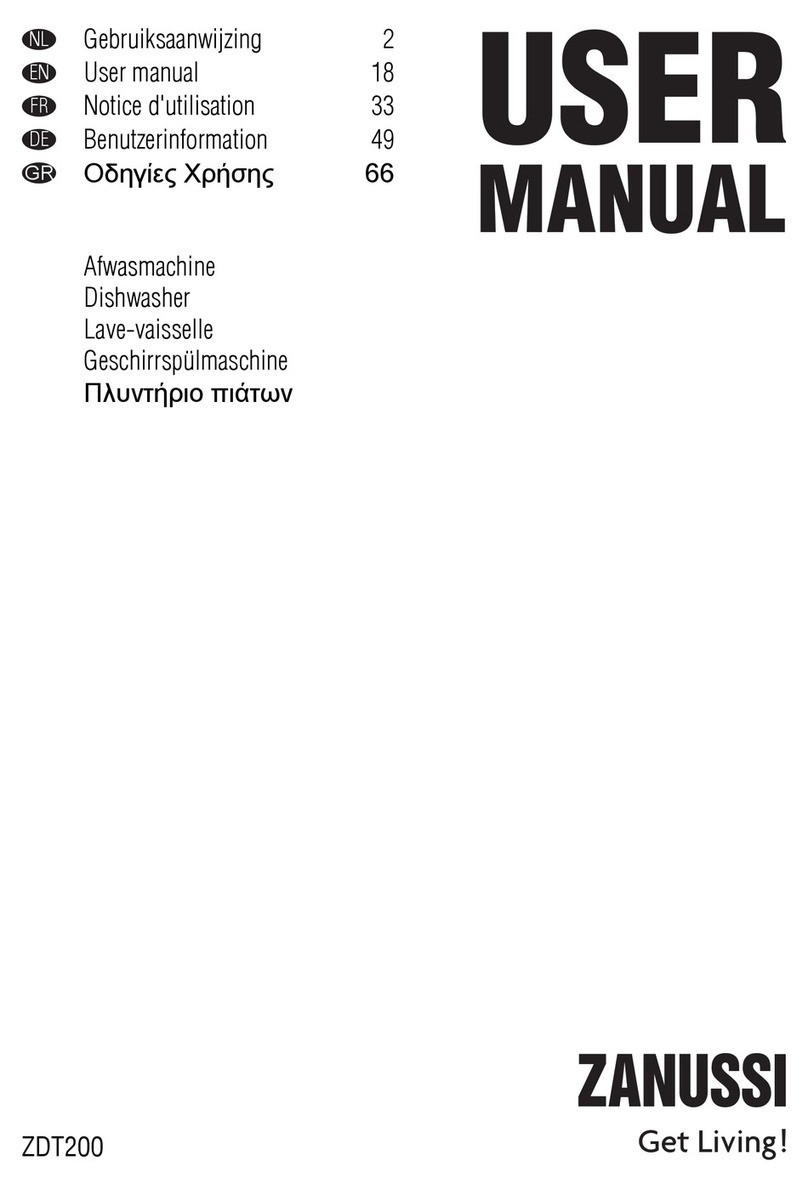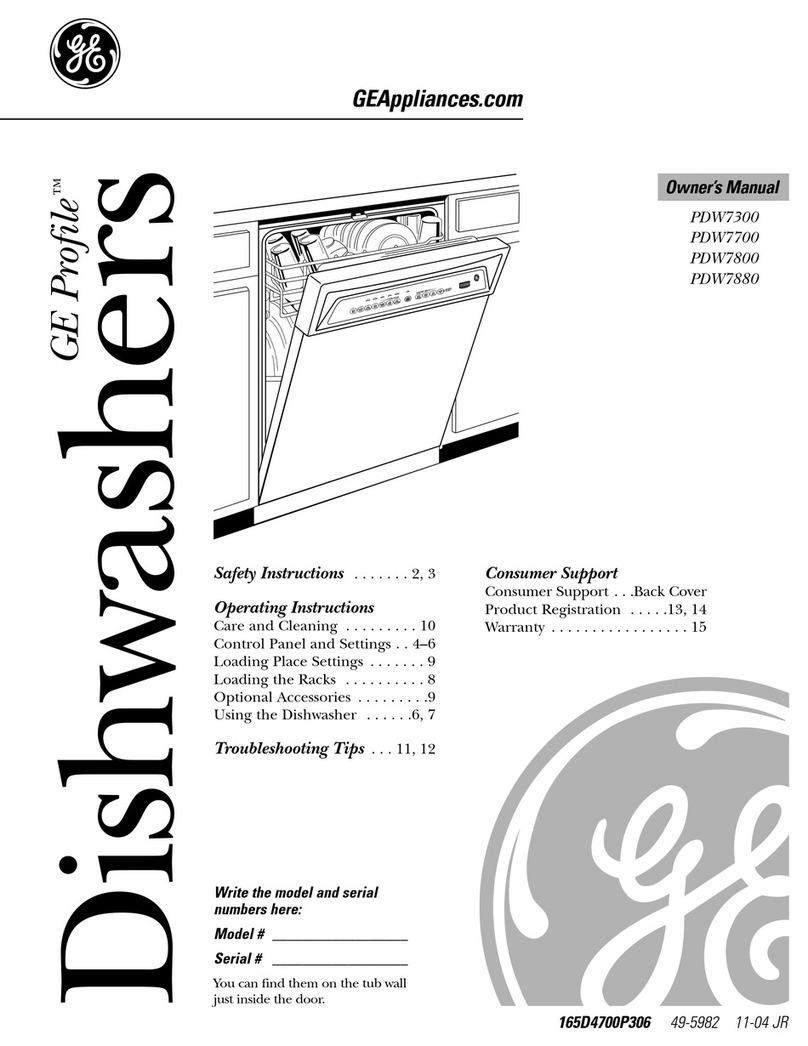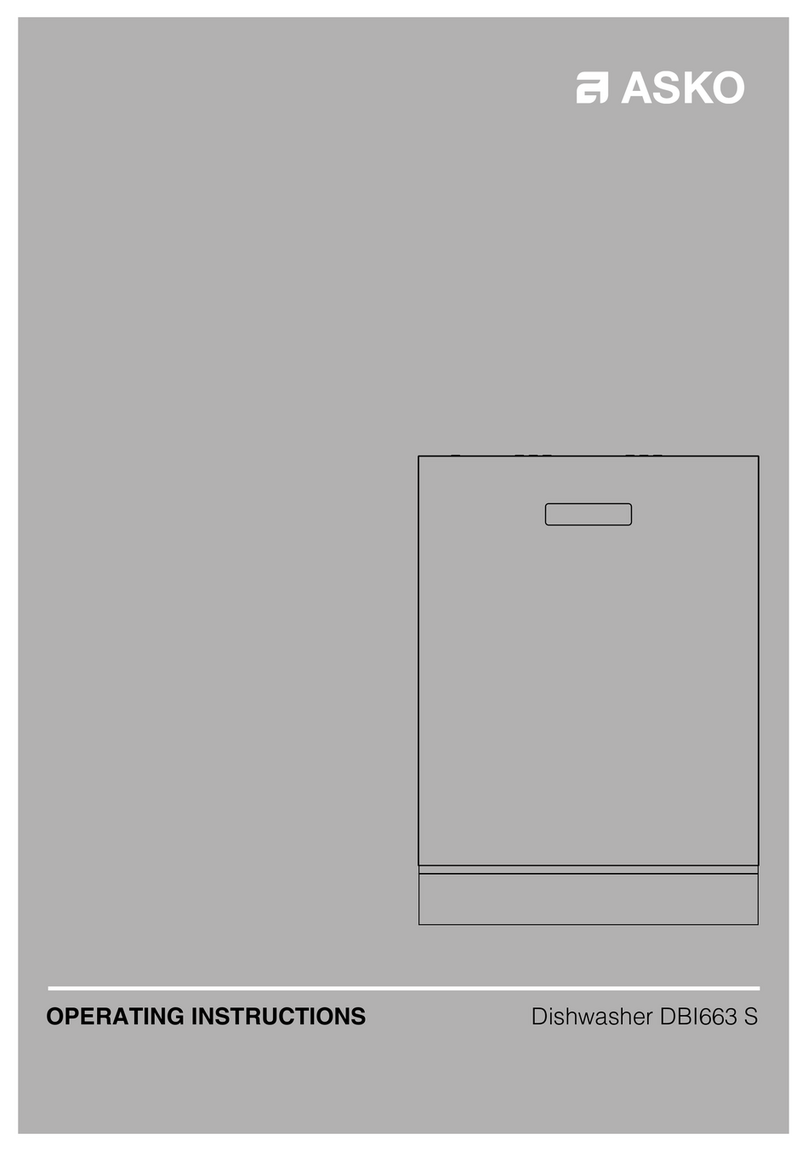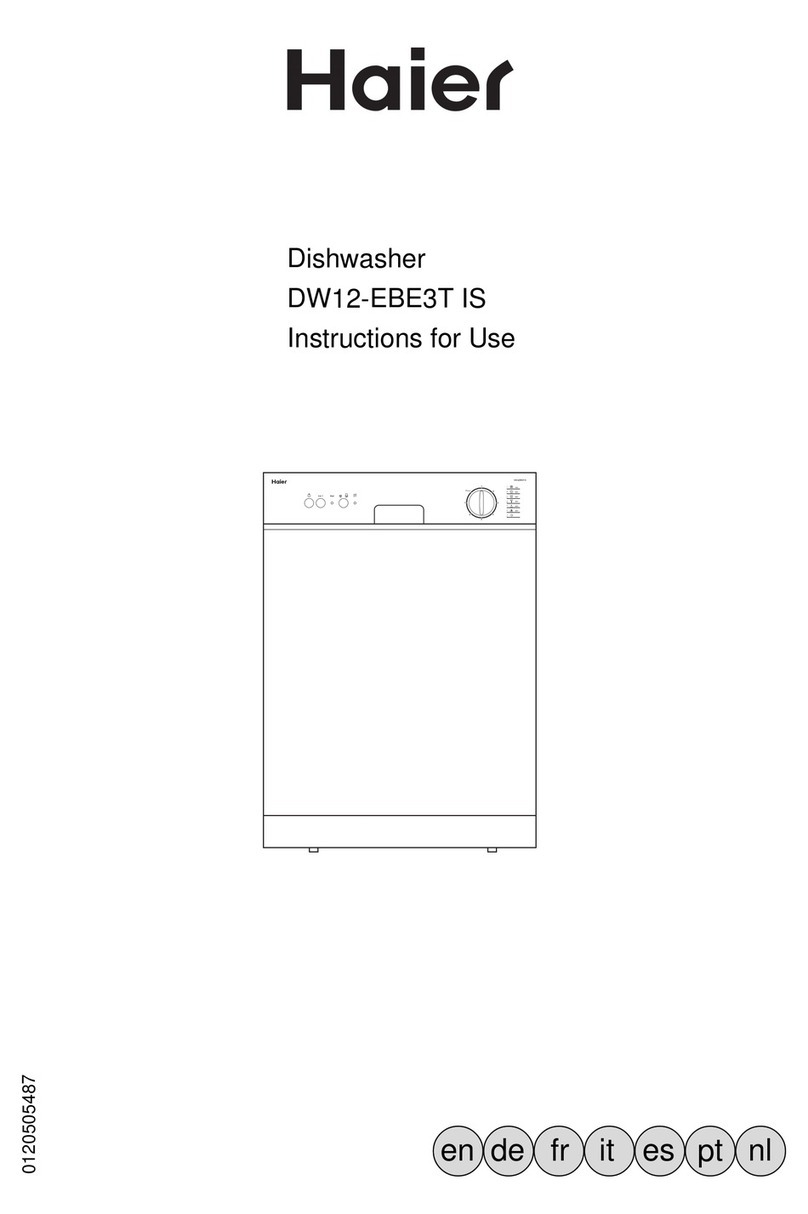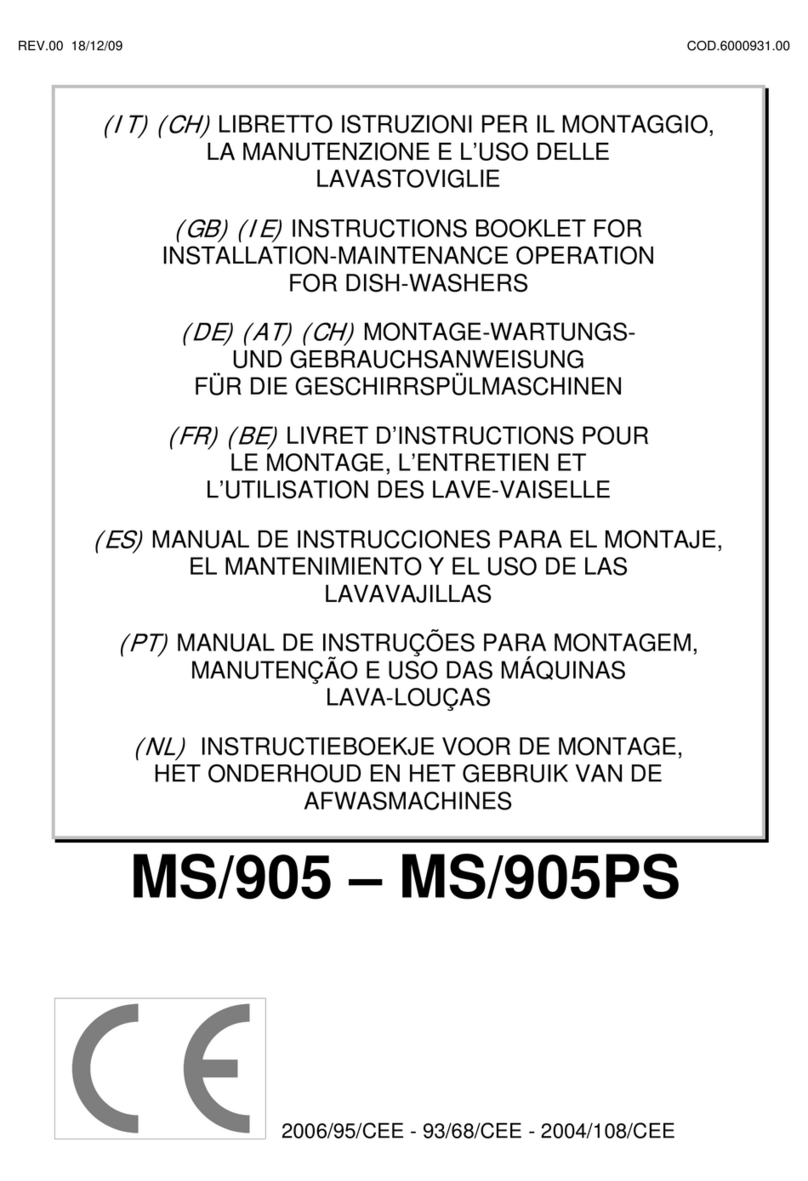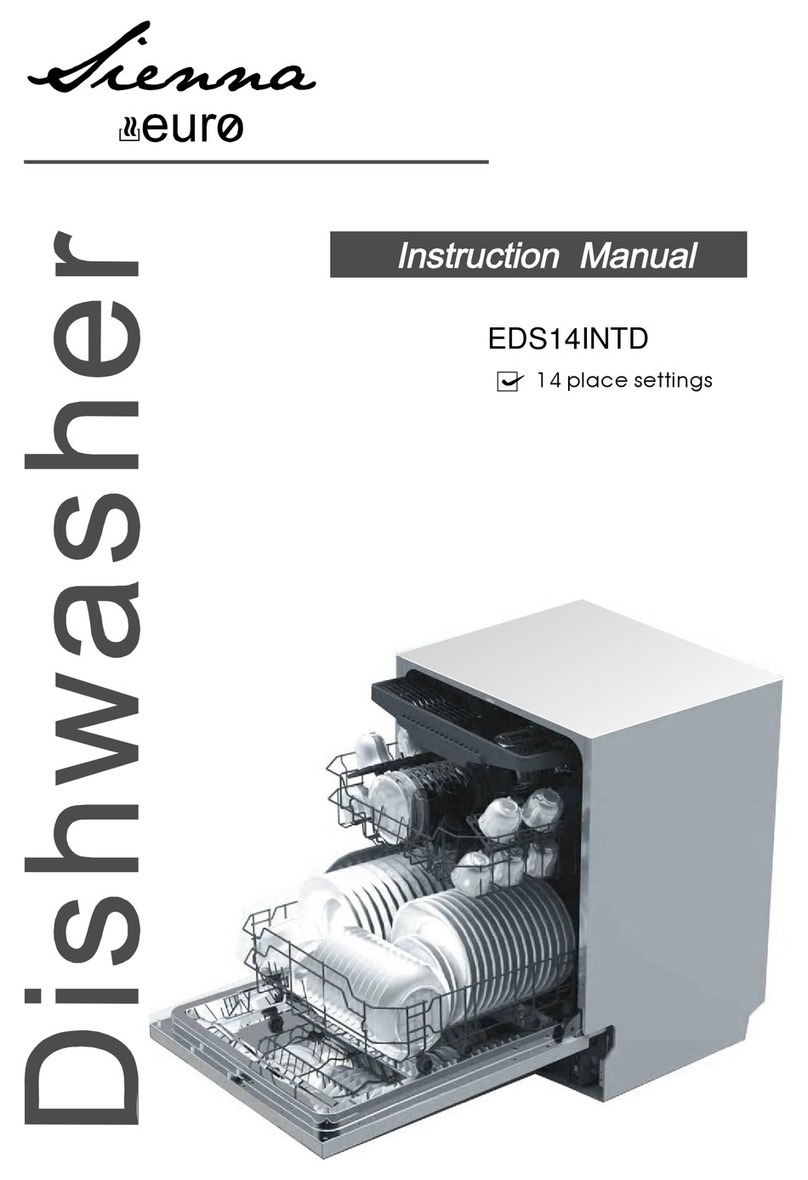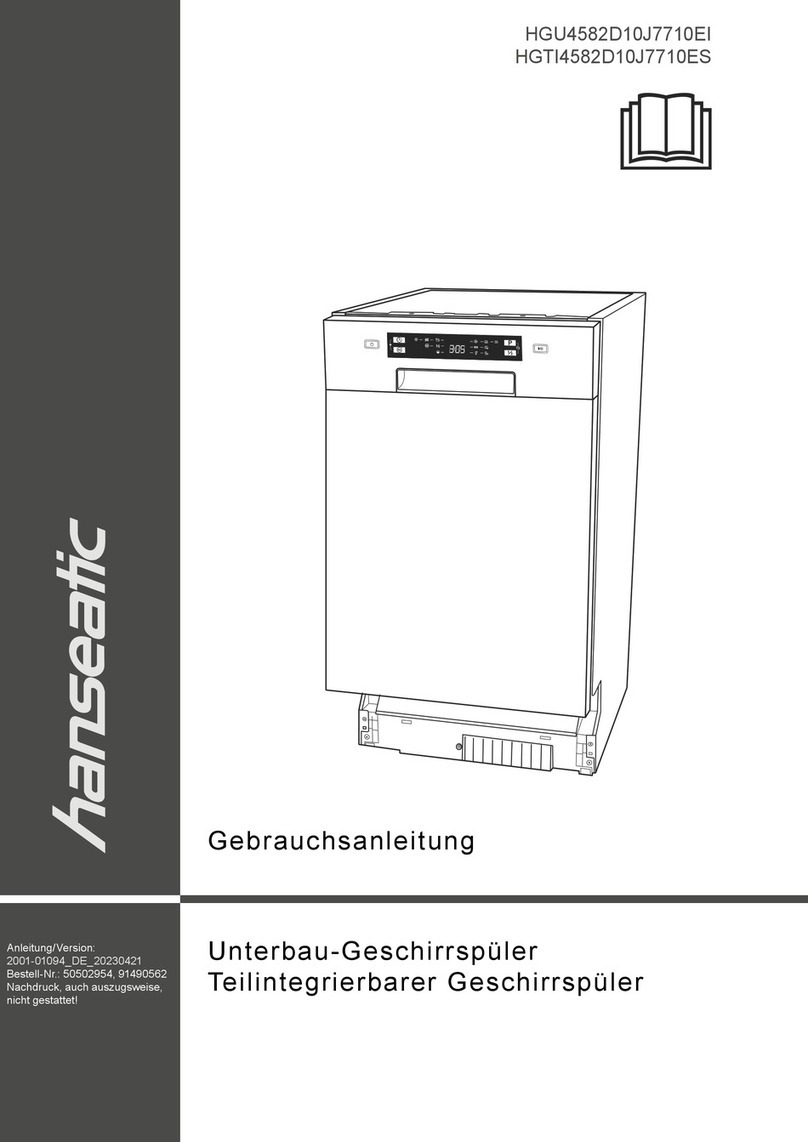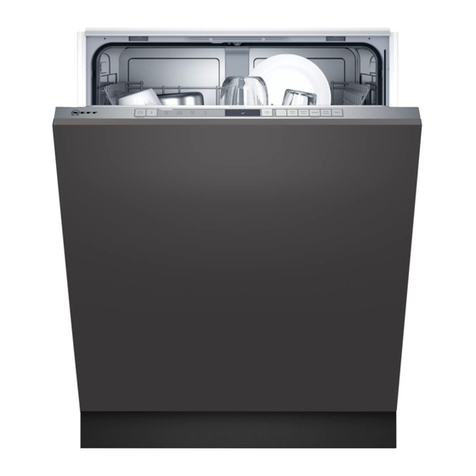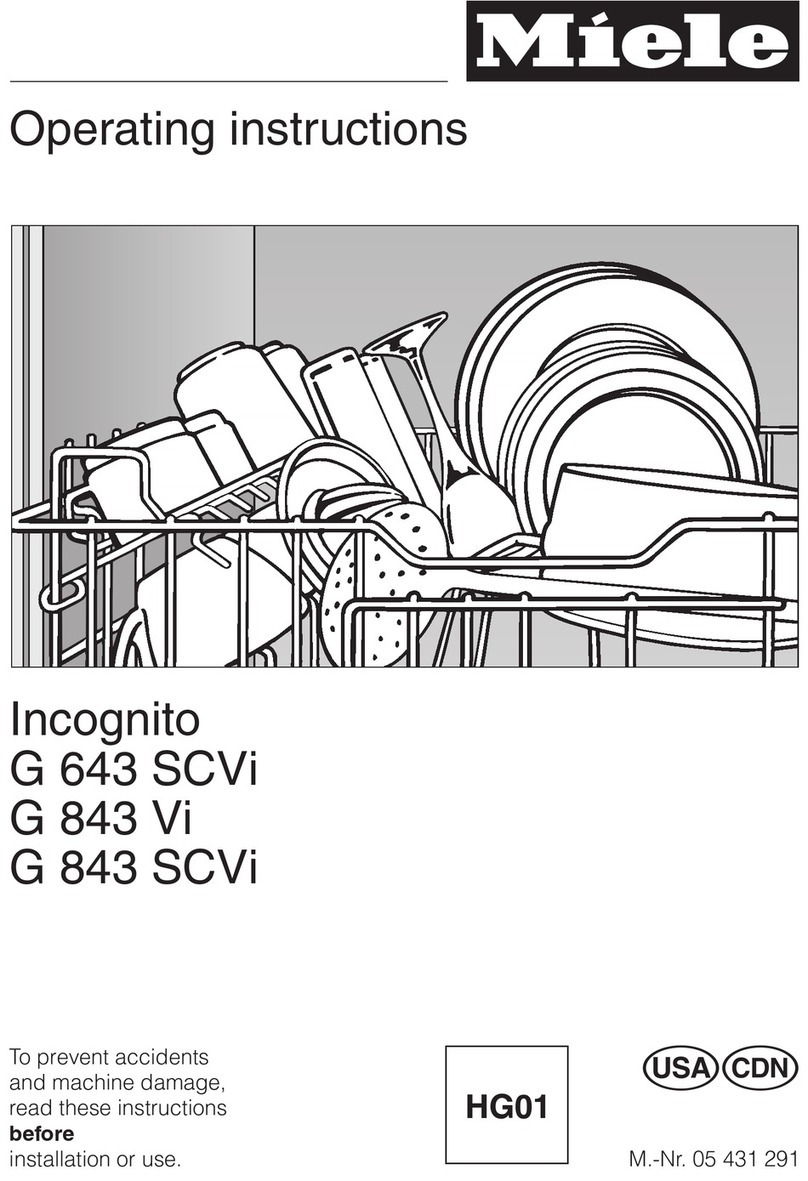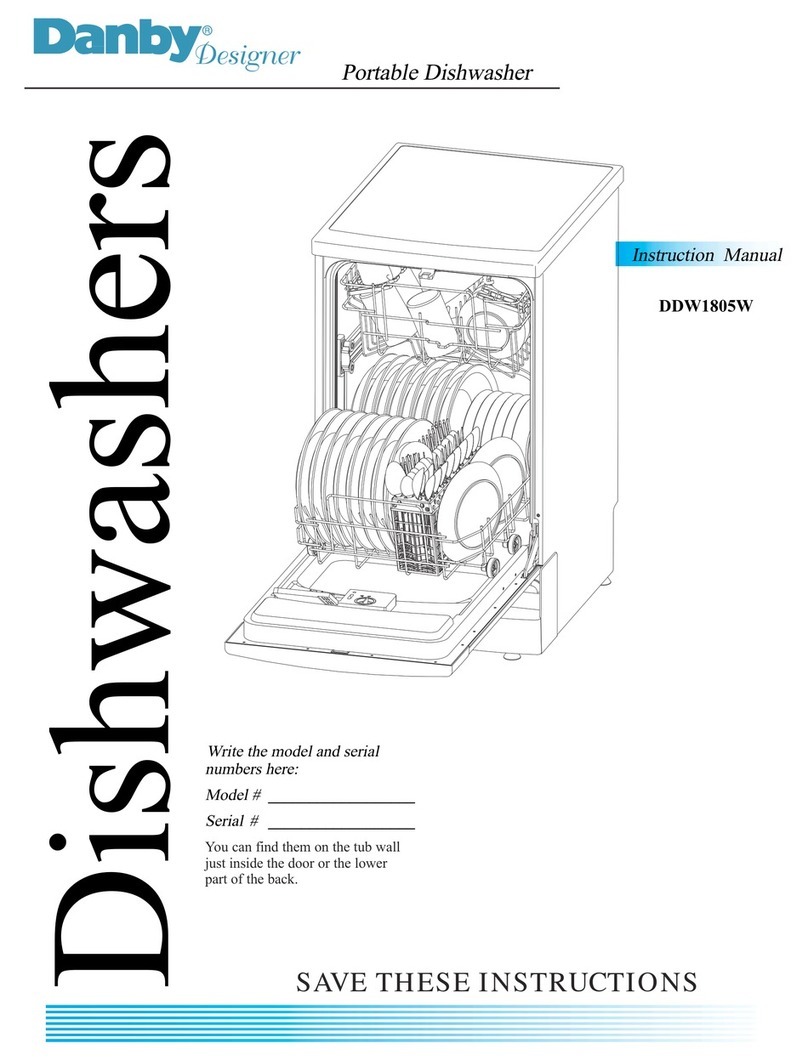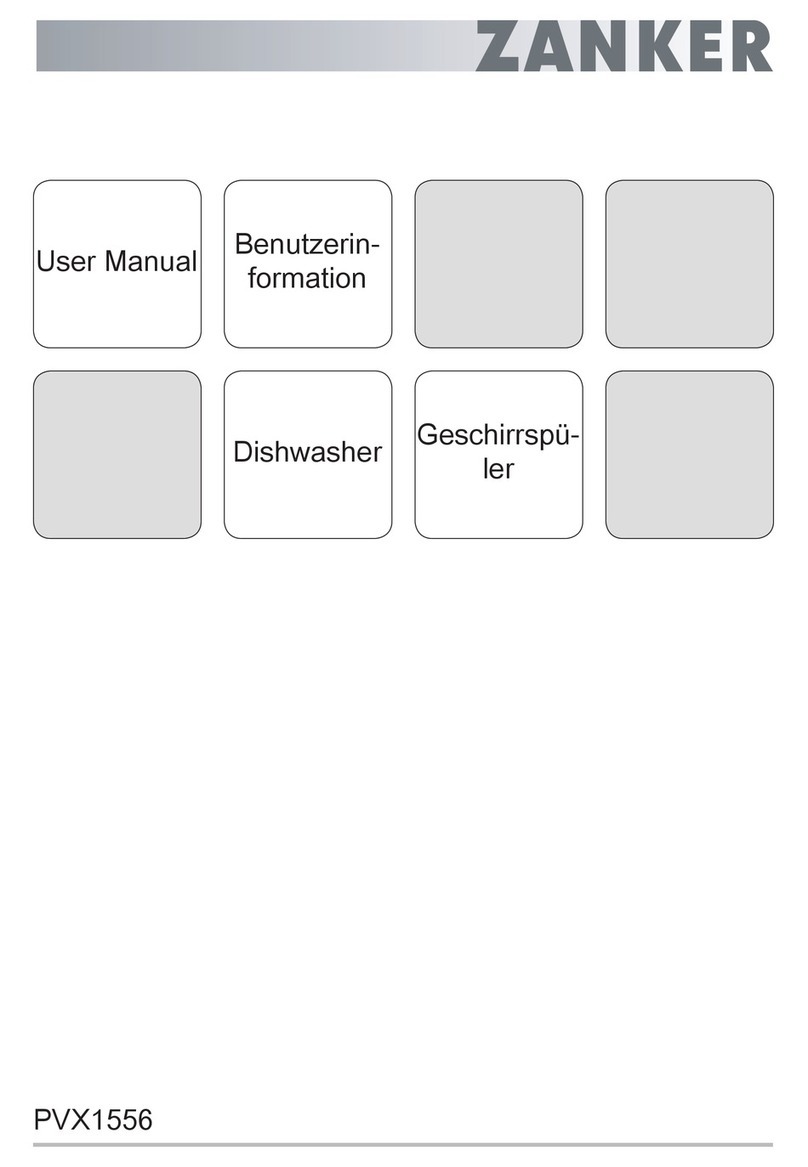Eswood CI-3B Technical Document

EQUIPMENT MANUAL
FOR
CI-3B COMPACT GLASS WASHER
JUNE 2011

ESWOOD OPERATING MANUAL CI-3B June 2011
2
T
ABLE OF CONTENTS
PAGE No.
1. Important: Prior to Installation 3
2. General Description 4
3. Technical Specifications 5
4. Installation -7
5. Initial Start-up Procedure 8
. Washing Operation 9
7. Shutdown and Maintenance 10
8. Trouble Shooting 11-12
9. CI-3B Export Model 13
10. Spare Parts 14-15
11. Wiring Diagram 1
12. Spare Parts & Service 17

ESWOOD OPERATING MANUAL CI-3B June 2011
3
I
MPORTANT
:
PRIOR TO INSTALLATION
1
Installation must be carried out according to local regulations by
qualified trade persons. Isolating switch(es), shut-off valves etc must
be within easy reach of the machine for future service and
maintenance requirements. If in doubt call ESWOOD AUSTRALIA or
their representative for further information. No responsibility will be
accepted for defects or damages by improper installation, for changes
to the product not authorised by ESWOOD AUSTRALIA, or for
operation outside the technical specifications.
ESWOOD AUSTRALIA warrants their products to be free from defects
in material and workmanship under "normal use and service". This
does not include normal wear and tear of parts. ESWOOD
AUSTRALIA will repair or replace any parts, which in ESWOOD
AUSTRALIA’s sole judgement are defective in material or
workmanship, in accordance with the warranty offered.
This undertaking covers the provision for labour and parts for 12
months from the date of delivery to the purchaser. This undertaking
applies only to state capitals. Remote areas are not covered by this
commitment and special enquires should be made. (Note: Tr vel
time not covered by w rr nty)
In no event will ESWOOD AUSTRALIA be liable for loss of facilities or
other property and such things as, but not limited to, additional labour
costs, loss of revenue or anticipated profits, and other damages of any
kind whether direct, indirect, incidental or consequential.
Labour under warranty is supplied free of charge during normal
working hours, Monday to Friday. Should warranty work be requested
outside of our normal working hours a labour charge will be applied
equivalent to a normal hour rate without out of hours penalty rates.
(Refer to last page of this manual for your closest branch for Warranty
repair services)
Note: It is the responsibility of the owner to ensure the water feed to
Eswood Dish and Glass washers is of a quality that will not form
excessive build up of calcium and other dissolved minerals on the
heating elements. Premature failure of heating elements that exhibit
this cause of failure will not be covered under warranty, also if the filter
valve is discarded from the detergent tube warranty will be voided.
PLEASE ENSURE SUITABLE DETERGENT IS USED.

ESWOOD OPERATING MANUAL CI-3B June 2011
4
G
ENERAL DESCRIPTION
2
Perform nce to M tch Your Needs: With a capacity to hygienically
wash 1800 glasses per hour, the CI-3B professional glass washer is
the perfect choice for your bar, cafe or coffee lounge. For the hustle
and bustle of a cocktail or lounge bar, the
CI-3B can be plumbed to provide a cold cycle after the final sanitising
rinse, and this would become a permanent part of the washing cycle.
Convenient R ck Size: The large wash chamber has been
designed to accept 430 x 3 0mm open wire glass racks which can
hold jugs or thirty 285ml (middy) glasses. An impact resistant 430 x
3 0mm nylon coated wire rack is supplied as standard.
Gl ss Cooling Cycle: This cycle is particularly useful for glasses
that are to be placed in a chillier, or can be used to cool down
glasses for a faster turn-around.
Convenient Design: The door is designed to provide a safe,
convenient and comfortable height for loading and unloading with
minimal bending. Safety is also assured thanks to a switch on the
door that prevents the machine from operating with the door open.
W sh System: Eswood’s wash system combines multiple jets on
rotating lower and upper wash and rinse arms, to produce a fast yet
spotless wash and rinse every time. The hygienic 82
O
C fresh water
wash/rinse is effectively directed from jets on the lower rotating arm,
and the cold final cycle is provided by the upper rotating arm.
Hot W ter Booster He ter: Automatic water temperature monitoring
and a powerful booster heater ensure that correct water temperature
is maintained for hygiene and optimum cycle times during continuous
use.
E sy Low Cost Inst ll tion: Simply connect the hot water supply,
plug the cord into a 15 Amp power point, and connect the trap to the
drain outlet.
Qu lity, Reli bility nd Perform nce: Eswood has a reputation for
product reliability that is second to none. The finest of stainless steel
and durable synthetic materials are used, and all Eswood products
are fully guaranteed and backed by a national support network.

ESWOOD OPERATING MANUAL CI-3B June 2011
5
T
ECHNICAL SPECIFICATIONS
3
M chine Specific tions
Net Weight 25kg
Washing Capacity 1800 glasses per hour
Cycle Time Red Button:- 19 second wash/rinse
Blue Button:- 15 second wash/rinse
- 15 second cooling.
Standard Equipment 430 x 3 0mm Open Wire Glass Rack
Rinse Cylinder nd Element
Rinse Cylinder Capacity 9
1
/
2
Litres
Booster Element 3000 Watts
W ter Input nd Consumption
Hot Water Input 5
O
C @ 250 to 400 kPa
Cold Water Input 250 to 400 kPa
Drain Outlet 2” B.S.P. gravity fed
Hot Water only usage 8 Litres per cycle
Hot and Cold water usage 4
1
/
2
Litres hot water
3 Litres cold water
Wash/Rinse Temperature 82
O
C to 85
O
C
Final Cycle Temperature Cold: 20
O
C
Hot: 5
O
C
Electric l Us ge
Electrical 240V, 50Hz, 1 phase, 12.5 Amps

ESWOOD OPERATING MANUAL CI-3B June 2011
6
I
NSTALLATION
4
1. Position on mounting brackets (already provided by others at
appropriate working height ) and remove the lower panel.
2. Connect the 2” B.S.P. gravity drain under the machine via a 2”
trap to the drain outlet.
3. Connect the hot water supply to the ¾” B.S.P. solenoid valve
labelled “HOT”. The hot water should be at a minimum of 5
O
C
and between 250 to 400 kPa. A pressure reducing valve should
be fitted for pressure above 400 kPa.
4. Connect the cold water supply to the ¾”B.S.P. solenoid valve
labelled “COLD”. The cold water supply should be between 250
to 400kPa. A pressure reducing valve must be fitted for
pressures above 400kPa.
If you do not require a permanent cooling cycle or your
glassware is sensitive to temperature changes then we suggest
that you do not use the cold water option and connect hot water
to this solenoid valve instead.
Do not m ke w ter or plumbing connections th t will
prevent the m chine from being removed from position, for
the purpose of servicing.
Note that all plumbing work is to be done in accordance with
local plumbing codes.
5. Ensure that the power switch is “OFF” and connect the three pin
plug lead to a 15 Amp, 240V, 50Hz, 1 phase power outlet.
Note that all electrical work is to be done in accordance with the
rating plate on the lower panel.
. The CI-3B comes standard with a detergent injection system
already set up.
7. Purge the rinse cylinder of air by opening water supplies to the
machine, switching the machine on and putting it through three
or four cycles.

ESWOOD OPERATING MANUAL CI-3B June 2011
7
SET POINT
(HOLE)
SET POINT
This ensures that the heating elements are safely covered with water.
F ilure to observe the bove will c use d m ge to the elements
th t is not covered under w rr nty.
8. Check for leaks, then reset the thermostats as follows:
1. The recycling thermostat located on the rinse cylinder
must be set so that the arrow on the knob points to the
centre of the hole on the mounting bracket. (See Fig.1)
2. The overriding thermostat adjustment is located at the
right hand side front corner of machine, to be adjusted by
turning the shaft clockwise (with a screwdriver) so that it
aligns with the silver line on the set point. (refer figure 2.)
9. Refit the lower panel.
OVERIDING THERMOSTAT FIGURE 1
CYCLING THERMOSTAT ON RINSE CYLINDER FIGURE 2

ESWOOD OPERATING MANUAL CI-3B June 2011
I
NITIAL START
-
UP PROCEDURE
5
1. The machine is shipped without water in the rinse cylinder and
with the thermostat set to 0
O
C. Check with your plumber that the
correct purge sequence has been carried out as per 7 & 8 of the
Installation instructions and that the thermostat has been set.
Note that the heating element must be safely covered with water
before the power is turned on. F ilure to observe the correct
procedure will c use d m ge to the element nd is not
covered under w rr nty
2. Check that the water supplies have been turned on and turn the
power on. The red “Machine On” pilot light will illuminate and the
machine will begin to heat the water. It will take about 10-15
minutes for initial heating to 82
O
C in the rinse cylinder.
3. Uncoil the clear 10mm diameter plastic hose tucked up under
the right hand side of the machine, and place the end into a bulk
container of commercial grade glass washing detergent. The
unit will prime itself after a few cycles.
Do not use wrong products as they will void the warranty, and
use products in accordance with the manufacturers’
recommendations. Note that the CI-3B has the detergent pump
set up to handle undiluted detergent. Do not dilute detergent.
4. When the “READY 82
O
C” light is on, press the Red button for an
all Hot cycle or Blue button for a Hot cycle followed by a Cooling
cycle. (the cooling cycle is only possible if Cold water has been
connected to the machine)
While the machine is running the amber “CYCLE ON” light is
illuminated.
Note that due to Health Regulations in some States, machines
in those States are fitted with a low temperature controller that
prevents the machine from starting until the wash/rinse water
has reached 82
O
C.

ESWOOD OPERATING MANUAL CI-3B June 2011
9
W
ASHING OPERATION
6
1. Check the level of detergent and fill when necessary with
undiluted detergent.
2. Turn the power on and the red “Machine On” pilot light will
illuminate. It will take about 10-15 minutes for initial heating of
water in the rinse cylinder.
3. Open the door, slide the rack in and close the door.
4. When the “READY 82
O
C” red pilot light is on, push the Red
button for a Hot cycle or Blue for a hot cycle followed by a
Cooling cycle. While the machine is running the amber
“CYCLE” light is illuminated. (refer figure 2.)
5. Occasionally check that the drain outlet is free from debris such
as paper, toothpicks and sliced fruit.
FIGURE 2.
RED BUTTON
ORANGE LIGHT
TOGGLE SWITCH
BLUE BUTTON
RED LIGHT
RED LIGHT

ESWOOD OPERATING MANUAL CI-3B June 2011
10
S
HUTDOWN AND MAINTENANCE
7
1. Turn the power off.
2. Remove any debris from the bottom of the wash chamber and
drain outlet.
3. Check that the upper and lower arms are free of foreign matter.
If necessary, remove the arms and clean them.
4. Clean the exterior of the machine with a damp sponge. Do not
pass water over the electrical controls and avoid abrasive or
strong detergents.
5. Check for leaks and ensure that the arms rotate freely.
. Leave the door open to allow the machine to air.

ESWOOD OPERATING MANUAL CI-3B June 2011
11
T
ROUBLE SHOOTING
8
Problem Possible c use nd remedy
When machine is (a) Check that main isolating switch is
turned on, red power turned on and fuses are okay.
light does not
illuminate (b) Power light may be burnt out. If so,
replace it (this will not stop machine from
operating though).
Machine will not start (a) Check operation of the door
switch.
(b) Ensure that the water temperature
has reached 82
O
C - operation may be
interlocked with temperature in your
State.
Poor water pressure (a) Check if water isolating valve
is
during wash/rinse fully open, and check for obstructions
in the water supply line.
(b) Check for obstruction in the water
supply solenoid valve and clean if
necessary.
Poor wash (a) Check that detergent feeder to
machine is operating correctly, and that
detergent container is not empty.
(b) Check for foreign matter in wash arm
jets. Clean if necessary.
(c) Check that glasses to be washed are
correctly placed in racks.
(d) Check temperature of rinse
cylinder. If incorrect check thermostat
setting and heating element.

ESWOOD OPERATING MANUAL CI-3B June 2011
12
Problem Possible c use nd remedy
Poor pressure from (a) Check that water pressure to
upper fixed jet machine is not less than 250 kPa. If so,
ensure that the water isolating valve is
fully open.
(b) Check for foreign matter and clean if
necessary.
(c) Check that the water supply solenoid
valve is functioning correctly.
(d) Check that the line strainer is not
partially blocked. If so, remove and clean
filter.
Insufficient rinse (a) Ensure that temperature of
temperature incoming water supply is at least 5
O
C.

ESWOOD OPERATING MANUAL CI-3B June 2011
13
CI-3B E
XPORT MODEL
9
The CI-3B supplied for export differs from Australian models as
follows:
1. An analog temperature gauge is provided as standard on all
export machines.

ESWOOD OPERATING MANUAL CI-3B June 2011
14
SPARE PARTS
10

ESWOOD OPERATING MANUAL CI-3B June 2011
15
SPARE PARTS
10
PART NO DESCRIPTION
EP-151 1 mm CABLE GLAND
EP-341 15 AMP PLUG AND LEAD
RT-134 TUBE, 5mm 10
EP-252 DETERGENT PUMP
PF-347 FILTER VALVE
B-2 49 UPPER WASH ARM ASSEMBLY
B-2895 LOWER WASH ARM ASSEMBLY
A-2512 MAGNET
A-2 2 COUNTER WEIGHT
190805 MAGNET HOUSING
SS-208 DOOR SWITCH
EP-149 TERMINAL STRIP
B-1332-2 BRACKET
SS-253 ELECTRONIC TIMER
SS-15 OVER-RIDE THERMOSTAT
SS-131 RINSE TANK THERMOSTAT
SS-1 1 PUSH BUTTON-RED
SS-1 0 PUSH BUTTON – GREEN
EP-132 TRANI LAMP – RED
EP-133 TRANI LAMP – AMBER
SS-147 TOGGLE SWITCH
EP-211 ELEMENT
B-1317 RINSE CYLINDER
B-1304-1 PANEL DECAL

ESWOOD OPERATING MANUAL CI-3B June 2011
16
WIRING DIAGRAM
11

ESWOOD OPERATING MANUAL CI-3B June 2011
17
GOLDSTEIN/E
SWOOD SPARE PARTS
&
SERVICE
12
For inquiries and access to 24/7 service backup, please call our Toll-Free Number:
(Applic ble to l ndline only ch rges pply for c lls m de from Mobile
Phone)
1800 013 123
This number will automatically access your nearest State office, or the technician
on duty if after hours. After hours charges apply.
Table of contents
Other Eswood Dishwasher manuals

